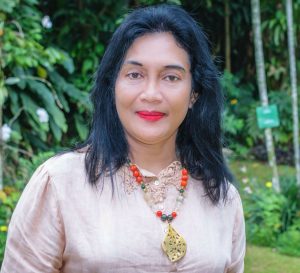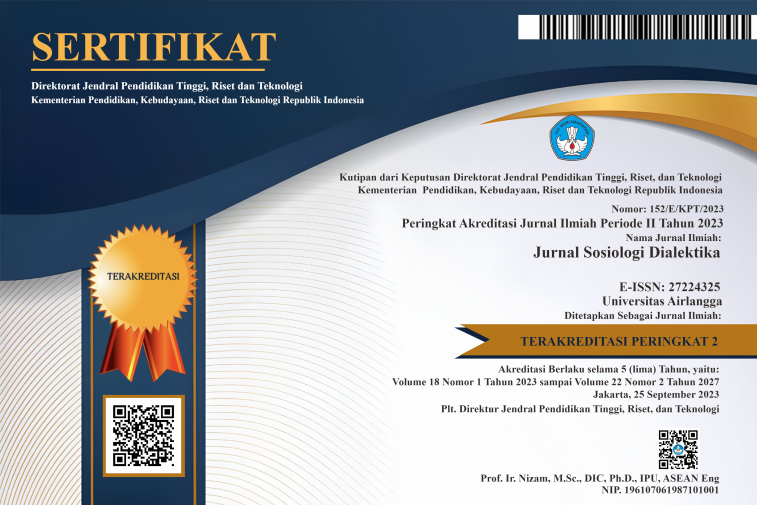The use of mixed methods to identify typology of poverty in East Java, Indonesia
Downloads
This article describes the results of concurrent mixed method testing to identify the typology of poverty in one particular area in East Java, Indonesia known as the "Madura Horseshoe". So far, typology studies of poverty in Indonesia use a single research method. The use of concurrent mixed methods is rarely done and even considered taboo in conventional research. The test results show that the method is very suitable to academic needs and very comprehensive in identifying the typology of poverty, particularly rampant poverty in an exclusive area with specific social structure and culture, namely those dominated by a particular ethnic group. The test concludes that the typology of poverty in the exclusive region of "Madura Horseshoe" is, in majority, a structural typology. The residents suffer from poverty because they do not have productive assets and social networks. Only a small percentage has cultural constraints, of which problems, including poverty, are solved by means of praying to God and asking blessings of sustenance. If this does not yield, they give up and resign to predestined fate.
Adams RH (2004) Economic growth, inquality and proverty: estimating the growth of poverty. World Development 32 (12):1989-2014.
Adhi MK, Ardana IK, & Maduriana IM (2016) faktor penyebab kemiskinan kultural dan model pengentasan berbasis kearifan lokal: Studi pada masyarakat miskin di Pegunungan Kintamani, Bali. Jurnal Kajian Bali 6 (2):229-246.
Ariadi S (2018) Optimalisasi program dan kegiatan Corporate Social Responsibility di Kota Bontang. Jurnal Sosiologi Dialektika 13 (1):31-47.
Ariyani N, Fauzi A, Juanda B, & Beik IS (2015) Evaluasi pogram pengentasan kemiskinan menggunakan metode rappoverty. Jurnal Ekonomi & Kebijakan Publik 6 (2):181-197.
Ashiomanedu J (2008) Poverty and sustainable development in the Niger delta region of Nigeria. Journal of Sustainable Development in Africa 10 (3):155-171.
Badan Pusat Statistik (2013) Profil Kemiskinan di Indonesia Maret 2013. Jakarta: Badan Pusat Statistik.
Banks LM, Kuper H, & Polack S (2017) Poverty and disability in low- and middleincome csountries: A systematic review. Plos One 12 (12):1-19.
Bourguignon F (2003) The poverty-growth-inquality triangle. In: Indian Council for Research on International Economic Relation, New Delhi, India.
Budirahayu T (2018) Perkembangan koperasi di Jawa Timur. Jurnal Sosiologi Dialektika 13 (1):88-95.
Cobbinah PB, Black R, Thwaites R (2013) Dynamics of poverty in developing countries: Review of poverty reduction approaches. Journal of Sustainable Development 6 (9):25 – 35.
Creswell JW (2009) Research Design: Qualitative, Quantitative and Mixed Methods Approaches. California, Thousand: Sage Publications.
Denzin NK & Lincoln YS et al (1997) Handbook of Qualitative Research. California: Sage Publication.
Domfeh KA & Bawole JN (2009) Localizing and sustaining poverty reduction: experiences from Ghana. International Journal of Management of Environmental Quality 20 (5):490-505.
Fosu AK (2017) Growth, inequality, and poverty reduction in developing countries: Recent global evidence. Research in Economics 71 (2):306 – 336.
Guiga H (2012) Poverty, growth and inequality in developing countries. International Journal of Economics and Financial Issues. International Journal of Economics and Financial Issues 2 (4):470 – 479.
Jordan G (2004) The causes of poverty cultural vs structural: Can there be a synthesis? Spring 14:18-34.
Marianti R & Munawar W (2006) Moving Out of Poverty: The Case of Desa Branta Pesisir, Kabupaten Pamekasan. Jakarta: SMERU Research Institute.
Meng X, Gregory R, & Wang Y (2005) Proverty, inquality and growth in urban china. Joural of Comparative Economics 33 (4):710 – 729.
Murdiyana & Mulyana (2017) Analisis kebijakan pengentasan kemiskinan di Indonesia. Jurnal Politik Pemerintahan 10 (1):73-96.
Perdana AA & Maxwell J (2004) Poverty Targeting in Indonesia: Programs, Problems and Lessons Learned. In: Centre for Strategic and International Studies Economic Working Paper Series, Jakarta, Indonesia.
Purwanto EA (2007) Mengkaji potensi usaha kecil dan menengah (UKM) untuk pembuatan kebijakan anti kemiskinan di Indonesia. Jurnal Ilmu Sosial dan Ilmu Politik 10 (3):295-324.
Rosfadhila M, Toyamah N, Sulaksono B, Devina S, Sodo RJ, & Syukuri M (2011) Kajian Cepat Pelaksanaan Program Bantuan Langsung Tunai (BLT) 2008 dan Evaluasi Penerimaan Program BLT 2005 di Indonesia. Jakarta: SMERU Research Institute.
Saptono A (2013) Evaluasi Program pengentasan kemiskinan (studi kasus pemberdayaan ekonomi pada Program Nasional Pemberdayaan Masyarakat Mandiri perkotan di Kelurahan Perwira Kecamatan Bekasi Utara Kotas Bekasi Jawa Barat. Econosains 11 (2):29-54.
Siahaan H (2012) Kemiskinan, Kesenjangan dan Keadilan: Sudahkah Pembangunan Benar-benar Pro-Rakyat? Surabaya: Departemen Sosiologi FISIP Unair.
Singgih DS (2009) Kemiskinan dan Implementasi Kebijakan Pro-Poor di Jawa Timur. Surabaya: Dewan Pakar Provinsi Jawa Timur.
Sudarso (2018) Kebijakan exit strategy mengatasi kenaikan harga BBM. Jurnal Sosiologi Dialektika 13 (1):18-30.
Sugandi YS (2016) Program penanggulangan kemiskinan perkotaan: Pengalaman Kota Bandung. Jurnal Analisis dan Pelayanan Publik 2 (1):109-128.
Sulhan M & Sasongko T (2017) Implementasi kebijakan program penanggulangan kemiskinan melalui Kartu Penjamin Soial dan Kartu Indonesia Pintar pada masyarakat. Jurnal Ilmu Sosial dan Ilmu Politik 6 (1):15-18.
Tashakkori A & Teddlie C (1998). Mixed Methodology: Combining Qualitative and Quantitative Approaches. Thousand Oaks California: Sage Publications.
Todaro PM & Smith SC (2006) Economic Development. Washington DC: Pearson Education Harlow.
Yuwinanto HP (2018) Pelatihan keterampilan dan upaya pengembangan UMKM di Jawa Timur. Jurnal Sosiologi Dialektika 13 (1):79-87.
1. Copyright of this journal is possession of Editorial Board and Journal Manager, by the knowledge of author, whilst the moral right of the publication belongs to the author.
2. Legal formal aspect of journal publication accessibility refers to Creative Commons Attribution-NonCommercial-ShareAlike (CC BY-NC-SA), implies that publication can be used for non-commercial purposes in its original form (cannot be modified).
3. Every publications (printed/electronic) are open access for educational purposes, research, and library. Other that the aims mentioned above, editorial board is not responsible for copyright violation.















